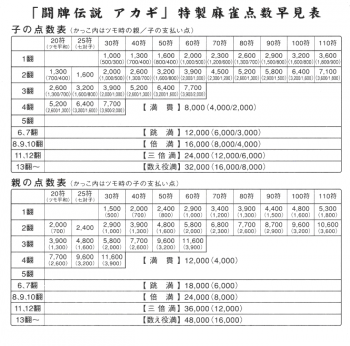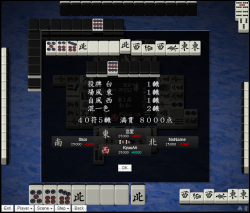Japanese mahjong scoring rules

Japanese mahjong features a complex scoring system. Nearly every mahjong hand has a value in terms of han and fu, which determine its point value. The han and fu are then plugged into an equation to determine the score. Alternatively, a scoring table can be used to find the point value directly.
Scoring factors
Han
Han 「飜」 are the main portion of scoring. Each yaku is assigned a value in terms of han: most are valued at 1-2, going up to 6 han for closed chinitsu. Each dora also grants +1 han. Han from yaku and dora are added up to produce a total han value.
Players are encouraged to know yaku, their han values, and how much points a given hand is worth. This knowledge may help with various game decisions, particularly when calling riichi or abandoning the hand.
As a general rule, for every +1 han, the hand roughly doubles in value until reaching 4 han. There is a "cap" at 2000 basic points (5 han; 4 han 40+ fu) - a hand that scores this much is called a mangan hand. Once reaching mangan, fu no longer matters for points, and han is reduced in value.
Fu
Fu 「符」 (pronounced as foo) takes the hand composition into consideration in terms of tile groups, wait patterns and/or win method.
Every hand begins with a default of 20 fu. Any extra sources of fu are added, and then rounded up to the next multiple of 10. The exception is with chiitoitsu yaku, which is fixed to 25 fu (and not rounded).
Fu does not impact scoring for hands that have at least 5 han.
Yakuman
The highest-scoring combinations are the yakuman patterns. A hand completing a yakuman is not scored for han and fu, but depending on the rules, it may be possible to combine multiple yakuman for an even larger hand.
Mangan

Mangan 「満貫」 is a point cap which limits the impact of han and fu once a hand reaches 2000 "base points". Since a regular player receives 4 × base points for winning, a mangan win is worth 8000 points (12000 points for dealers).
Mangan is reached with 3 han and 70 fu, 4 han and 40 fu, or 5 han. Once a hand reaches mangan, increasing fu will no longer affect scoring, and han has a reduced effect.
Below mangan, every han roughly doubles the hand's score. Past it, each han can still increase the hand's score, but in set intervals. These values, like mangan, have their own names:
- 6-7 han: Haneman 「跳満」 = 12000 for a nondealer and 18000 for the dealer; 50% more than mangan (x1.5)
- 8-10 han: Baiman 「倍満」 = 16000 for a nondealer and 24000 for the dealer; 100% more than mangan (double)
- 11-12 han: Sanbaiman 「三倍満」 = 24000 for a nondealer and 36000 for the dealer; 200% more than mangan (triple)
- 13+ han: Kazoe yakuman 「数え役満」 = 32000 for a nondealer and 48000 for the dealer; 300% more than mangan (quadruple)
- Some rulesets don't use kazoe yakuman, in which case 13+ han hands are worth sanbaiman.
- Yakuman: Points are the same as kazoe yakuman.
- Multiple yakuman: Points are the value of yakuman multiplied by the number of yakuman the hand contains.
Kiriage mangan
Kiriage mangan 「切り上げ満貫」, or "rounded up mangan", is a scoring variation that modifies mangan. When kiriage mangan is enabled, a 4 han and 30 fu hand, as well as a 3 han 60 fu hand, are considered mangan. The difference between a regular 4 han 30 fu hand (worth 7700 or 7900 points for non-dealers) and mangan is not very large, so these values are rounded up for convenience.
Kiriage mangan is reasonably common to see in real life play, though most computer clients do not use this rule.
Scoring procedure
Calculating basic points
To determine the point value of a hand, the following procedure is used:
- If the hand is a yakuman, then the hand scores 8,000 basic points.
- If double yakuman are used, a double yakuman scores 16,000 basic points. If multiple (>2) yakuman are used, points are multiplied accordingly.
- Otherwise, determine all of the hand's valid yaku and determine the amount of dora. Count the number of han from these sources.
- Some yaku combinations such as chanta + junchan are not compatible with each other.
- If the han count is 5 or more, then counting fu is no longer necessary. The hand is scored according to its han value:
- 5 han: mangan hand worth 2,000 base points.
- 6-7 han: haneman hand worth 3,000 base points.
- 8-10 han: baiman hand worth 4,000 base points.
- 11-12 han: sanbaiman hand worth 6,000 base points.
- If the han count is 4 or less, then count fu.
- If the hand is not seven pairs, round the fu up to the nearest 10.
- To get the base points, plug in the equation
fu × 2(2 + han) - If playing with kiriage mangan, round a 1,920-point hand up to a 2,000-point mangan.
- In any case, if the base points value would be above 2,000 for a hand with 4 or fewer han, it is instead a 2,000-point mangan.
Payment multipliers
After determining the basic points, multiply based on the status as dealer and non-dealer as well as the win by ron or tsumo.
- When a non-dealer wins by tsumo, the player is paid 1 × basic points by the other non-dealers, and 2 × basic points by the dealer.
- When a non-dealer wins by ron, the discarding player pays the winner 4 × basic points.
- When the dealer goes out by tsumo, the player is paid 2 × basic points from all other players.
- When the dealer goes out by ron, the discarding player pays the winner 6 × basic points.
Each value to be paid is rounded up to the nearest 100. Because of how this rounding works, the totals for tsumo and ron do not always match. (For example, a 1 han 30 fu hand scores 240 basic points. Without rounding, a ron would score 960 points, and a tsumo would also score 240+240+480 = 960 points. As each individual player's payment is rounded, ron scores 1000, and tsumo scores 300+300+500 = 1100, or 100 more than ron.)
To explain this in different terms: when hand wins by ron, the ronned player pays 100% of the hand's value. When a hand wins by tsumo, each player splits the payment evenly (with the dealer paying double).
Honba
In addition to the points for the hand, the winner is paid a small sum of points based on the number of honba counters on the table. Thus, for every renchan, the value of a winning hand slowly increases
Oyakaburi
Oyakaburi 「親かぶり」 is when a non-dealer player wins by tsumo, causing the dealer to pay more than non-dealer players. This term usually refers to high value tsumos, which can cause the dealer to drop down placement.
Scoring Table
Since the han and fu equation is always the same, it is possible to use a scoring table to score the hand. Simply calculate the hand's han and fu, then find the values on the table. See scoring table for the actual table.
For details on how to memorize scoring, see score table memorization.
End game score
At the end of the game, the raw points are used to calculate the end game score. These are the two or three digit +/- numbers used to reflect a player's score. For example:
- A player ends the game with 40,000 points.
- The starting value of 25,000 points is subtracted, leaving +15,000 points.
- To make the values easier to read, 15,000 is divided by 1,000, for a value of +15.0 points.
- This +15 value may be affected by uma (a bonus/penalty for placing 1st/2nd/etc.).
Aotenjou
Aotenjou is a rarely played variant which removes the mangan limit. Under aotenjou:
- Each han doubles the hand value without limit. E.g., a 5 han 30 fu hand is 8000 in standard rules, and 15360 in aotenjou.
- Fu matters even for hands with 5 or more han.
- Yakuman are scored as 13-han yaku.
External links
- Japanese mahjong scoring rules in Japanese Wikipedia